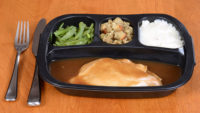USDA-FSIS Releases HACCP Model for Thermally Processed, Commercially Sterile Products

The U.S. Department of Agriculture Food Safety and Inspection Service (FSIS) has released an update to its "Hazard Analysis and Critical Control Points (HACCP) Model for Thermally Processed, Commercially Sterile Product" guideline. This replaces the 1997 version of the Thermally Processed Commercially Sterile model.
The new guideline says that thermally processed, commercially sterile (TPCS) products are commonly referred to as canned products although the containers can be metal cans, glass jars, flexible pouches, paperboard, and other types of hermetically sealed containers. Processors of TPCS products must identify their biological, physical, and chemical food safety hazards when performing their hazard analysis.
Under 9 CFR 417.2(b)(3) of the HACCP regulations, businesses and other establishments do not have to address microbiological food safety hazards identified in its hazard analysis if the product is produced in accordance with the requirements of 9 CFR Part 431. However, canning establishments that identify chemical or physical food safety hazards as reasonably likely to occur are to address those hazards in their HACCP plan.
The regulations say that canning establishments don't have to address microbiological hazards in their HACCP plan because FSIS recognized that the canning regulations were based on HACCP concepts and provide for the analysis of thermal processing systems and controls to exclude biological food safety hazards. However, a canning establishment may choose to address the microbiological food safety hazards in its HACCP plan. In either case, the requirements in 9 CFR parts 431 and 417 must be met through the establishment’s HACCP system.
This HACCP model illustrates the scenario when the establishment does not address microbiological hazards in a HACCP plan and does not identify chemical or physical food safety hazards as reasonably likely to occur. Thus, this model does not include any CCPs. This model does contain the required product description, list of product ingredients and materials, flowchart, and hazard analysis. The model may not necessarily apply to all operations or products. Products or operations may require CCPs depending on the operation.
Click here to read the full guideline.
Looking for a reprint of this article?
From high-res PDFs to custom plaques, order your copy today!





